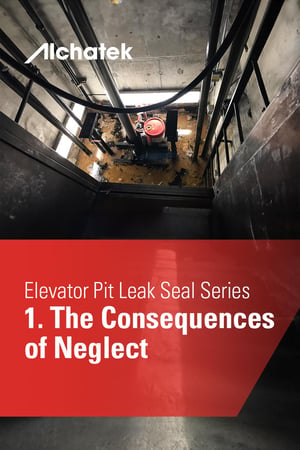
 In the world of commercial and industrial buildings, hydraulic elevators are a common fixture. Integral to these systems are elevator pits, located at the bottom of the elevator shaft. They house important components that facilitate the elevator's movement. While often overlooked, these pits are vital for the smooth operation and safety of the elevator system.
In the world of commercial and industrial buildings, hydraulic elevators are a common fixture. Integral to these systems are elevator pits, located at the bottom of the elevator shaft. They house important components that facilitate the elevator's movement. While often overlooked, these pits are vital for the smooth operation and safety of the elevator system.
The Problem of Water Leakage
Water leakage in elevator pits can arise from various sources such as groundwater seepage or pipe leaks. Irrespective of the source, the presence of water in these pits is not a situation to be taken lightly. It poses risks not only to the elevator system's integrity but also to the overall safety and compliance of the building.
Consequences of Ignoring Water Leakage
One of the gravest concerns with water accumulation in elevator pits is its potential to mix with the hydraulic oil used in the elevator system. This mixture creates an environmental and safety hazard known as oily water. Oily water presents several challenges:
- Environmental and Safety Hazards: The mixture of oil and water can lead to environmental contamination. Additionally, it poses a significant fire risk, given the flammability of hydraulic oil.
- Equipment Damage: Prolonged exposure to water can lead to corrosion and failure of critical elevator components. This not only leads to increased maintenance costs but can also result in costly downtime for repairs.
- Legal and Regulatory Implications: The creation of oily water can violate environmental regulations, leading to potential fines and legal action. Buildings are required to adhere to strict environmental standards, and failure to manage oily water properly can result in severe penalties.
The risks highlighted above underscore the importance of addressing water leakage issues promptly. Early detection and repair can prevent the formation of oily water, saving property owners from the expensive and complex process required for its removal.
The Solution
The next post will cover the solution to this problem – the use of polyurethane grout. This innovative method offers an effective and long-lasting solution to water leakage issues, ensuring the safety and compliance of elevator systems.




 Your home is more than just a structure; it's a sanctuary, a place where memories are made and cherished. Ensuring its stability and safety is paramount. If you've noticed cracks, unevenness, or other signs of instability in your basement floor, it's time to take action.
Your home is more than just a structure; it's a sanctuary, a place where memories are made and cherished. Ensuring its stability and safety is paramount. If you've noticed cracks, unevenness, or other signs of instability in your basement floor, it's time to take action.


 Your home's basement floor serves as an integral component of the structure, playing a pivotal role in maintaining the overall stability and integrity of the house. However, like all parts of a home, it's subject to wear and tear, and there are times when it might need professional attention. Recognizing these moments is crucial not just for the health of the structure but also for the safety of its inhabitants.
Your home's basement floor serves as an integral component of the structure, playing a pivotal role in maintaining the overall stability and integrity of the house. However, like all parts of a home, it's subject to wear and tear, and there are times when it might need professional attention. Recognizing these moments is crucial not just for the health of the structure but also for the safety of its inhabitants.

 Ensuring the stability of your basement floor is an imperative task for every homeowner. Yet, in our pursuit of a sturdy home, it is crucial not to overlook the environmental ramifications of repair materials and methods. Balancing these dual responsibilities can be challenging, but with informed choices, homeowners can achieve both goals seamlessly.
Ensuring the stability of your basement floor is an imperative task for every homeowner. Yet, in our pursuit of a sturdy home, it is crucial not to overlook the environmental ramifications of repair materials and methods. Balancing these dual responsibilities can be challenging, but with informed choices, homeowners can achieve both goals seamlessly.
 The basement, being one of the most vital components of a home, requires solutions that are both efficient and long-lasting when it comes to addressing unstable floor slab issues. Traditional methods of repair, although effective, can often be invasive, time-consuming, and expensive. Enter polyurethane foam—a revolutionary solution to basement floor slab stability issues.
The basement, being one of the most vital components of a home, requires solutions that are both efficient and long-lasting when it comes to addressing unstable floor slab issues. Traditional methods of repair, although effective, can often be invasive, time-consuming, and expensive. Enter polyurethane foam—a revolutionary solution to basement floor slab stability issues.
 For many homeowners, a basement represents more than just a foundation—it's an extension of their living space, a storage haven, or even a cozy retreat. Ensuring the structural integrity and safety of your basement is paramount, not just for the sake of the basement itself but for the overall health and well-being of your home and its inhabitants. The basement floor is a critical component that plays a significant role in ensuring your basement is dry, stable, and safe.
For many homeowners, a basement represents more than just a foundation—it's an extension of their living space, a storage haven, or even a cozy retreat. Ensuring the structural integrity and safety of your basement is paramount, not just for the sake of the basement itself but for the overall health and well-being of your home and its inhabitants. The basement floor is a critical component that plays a significant role in ensuring your basement is dry, stable, and safe.
 For municipalities, the adoption of polyurethane grout represents a commitment to cost efficiency, sustainability, and long-term planning. The following outlines the steps municipalities can take to effectively implement polyurethane grout solutions, ensuring that technical proficiency goes hand-in-hand with the economic benefits.
For municipalities, the adoption of polyurethane grout represents a commitment to cost efficiency, sustainability, and long-term planning. The following outlines the steps municipalities can take to effectively implement polyurethane grout solutions, ensuring that technical proficiency goes hand-in-hand with the economic benefits.
 In the realm of wastewater management, the conversation around repair methods is often punctuated by the concern for cost. For municipal managers and administrators, understanding the financial implications of infrastructure repair decisions is as crucial as comprehending their technical benefits.
In the realm of wastewater management, the conversation around repair methods is often punctuated by the concern for cost. For municipal managers and administrators, understanding the financial implications of infrastructure repair decisions is as crucial as comprehending their technical benefits.
 Municipal managers and administrators may be interested in the ways in which polyurethane grout can be strategically applied to different structures within the wastewater system—manholes, pipes, and lift stations—to ensure efficient, cost-effective operations.
Municipal managers and administrators may be interested in the ways in which polyurethane grout can be strategically applied to different structures within the wastewater system—manholes, pipes, and lift stations—to ensure efficient, cost-effective operations.
 In the quest to maintain robust wastewater infrastructure, polyurethane grout emerges as a material that exhibits superior sealing capabilities, flexibility, and longevity. Its unique chemical structure allows it to expand upon contact with water, creating an effective and durable seal that traditional materials cannot match.
In the quest to maintain robust wastewater infrastructure, polyurethane grout emerges as a material that exhibits superior sealing capabilities, flexibility, and longevity. Its unique chemical structure allows it to expand upon contact with water, creating an effective and durable seal that traditional materials cannot match.